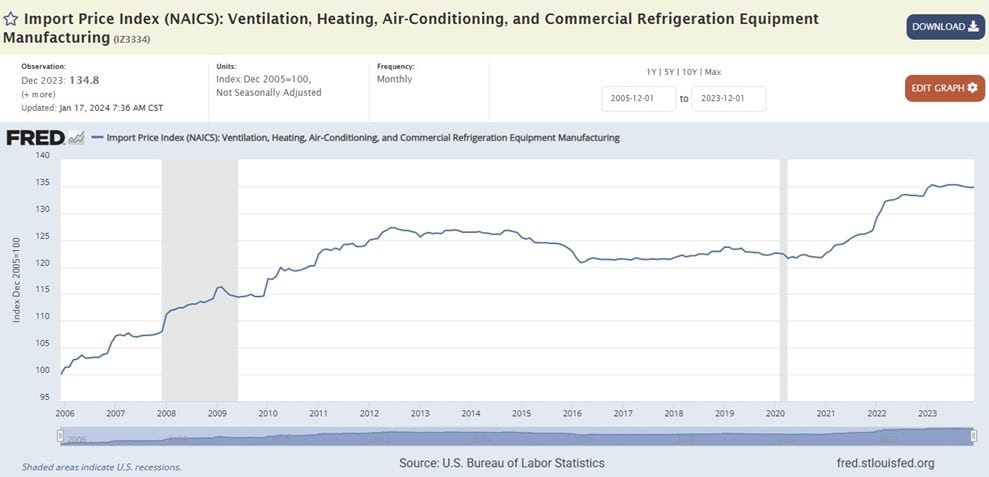HVAC Industry Braces for Higher Prices as Tariffs Loom
- General Management
Article Summary
On January 1st, 2025, President Trump signed executive orders imposing 25% tariffs on goods imported from Canada and Mexico, and an additional 10% tariff on Chinese goods. These tariffs will lead to increased costs for HVAC equipment and components from Mexico, Canada, and China. Manufacturers are likely to pass these additional costs on to consumers, resulting in higher prices for HVAC products and services across the USA.
From the White House
“The tariffs take effect on Tuesday and will remain in place “until such time as drugs, in particular fentanyl,
and all illegal aliens stop this invasion of our Country,”
The Impact of Tariffs on the HVAC Industry
The recent imposition of tariffs, 25% on imports from Mexico and Canada, and 10% on Chinese imports, will significantly impact the HVAC industry, leading to increased costs for equipment and components. Since virtually no company produces a net profit in excess of 25%, it seems to me that these additional expenses are going to be passed on to consumers, resulting in higher prices for HVAC products and services.
Impact by Country
Mexico:
Several major HVAC manufacturers have substantial manufacturing operations in Mexico. The 25% tariff on Mexican imports will affect products such as air conditioners, furnaces, and various components. Companies like Carrier, Daikin, Lennox, and Trane, which hold over a 60% share of the U.S. market, have manufacturing exposure in Mexico.
Canada:
Canada is a significant supplier of raw materials, including steel and aluminum, which are essential for HVAC equipment production. The 25% tariff on Canadian imports will increase the cost of these materials, thereby raising production expenses for HVAC manufacturers. This escalation in costs is anticipated to be transferred to consumers through higher prices for HVAC systems and components.
China:
China is a major exporter of HVAC components, such as heat pumps and control systems. The 10% tariff on Chinese imports will affect products like heat pumps, thermostats, and various electronic controls. Companies such as Sanhua, a global manufacturer of controls and components for HVAC and refrigeration systems, will be impacted.
HVAC Related Inflation Outpaces the National Average
While the general inflation rate has been around 2.9%, the HVAC industry has faced price increases significantly above this average, primarily due to rising material costs, supply chain challenges, and regulatory changes.
According to data sourced from the U.S. Bureau of Labor Statistics, between 2020 and 2024, the HVAC industry experienced a significant increase in equipment prices, with reports indicating a rise of approximately 40% during this period. This surge is notably higher than the general inflation rate for all goods and services, which was 2.9% in December 2024.
What is the Cause of HVAC Equipment Inflation?
The substantial increase in HVAC equipment prices can be attributed to several factors:
Rising Material Costs: Essential materials for HVAC manufacturing, such as copper, aluminum, and steel, have seen significant price hikes. For instance, domestic producers of metal products have increased their selling prices by over 42% since 2020.
Supply Chain Disruptions: Global supply chain issues have led to shortages and delays, further driving up costs for HVAC components and finished products.
Regulatory Changes: New environmental regulations requiring the use of more eco-friendly refrigerators have increased production costs, contributing to higher prices for consumers.
Conclusion
The HVAC industry is facing a perfect storm of rising costs due to tariffs, inflation, supply chain disruptions, and regulatory changes. With a 25% tariff on imports from Mexico and Canada and a 10% tariff on Chinese imports, manufacturers will inevitably pass these increased expenses onto consumers. Essential HVAC products such as air conditioners, furnaces, heat pumps, and control systems will see significant price hikes, making it more expensive for businesses and homeowners to maintain and upgrade their systems.
Furthermore, inflation in the HVAC sector has far outpaced the national average, with equipment prices rising by approximately 40% between 2020 and 2024. With costs for raw materials like steel, aluminum, and copper continuing to rise, the industry will likely see further price increases in the coming years. For contractors, businesses, and homeowners, staying informed about these trends will be crucial for planning future HVAC investments and maintenance.

About James R. Leichter
James R. Leichter, renowned HVAC business consultant, author, and public speaker, is dedicated to empowering HVAC businesses with innovative strategies and insights. Leichter, affectionately known as ‘Mr. HVAC,’ brings over 27 years of industry expertise and a passion for practical solutions, assisting HVAC businesses to streamline operations and maximize profits. Discover transformative guidance at MrHVAC.com.
